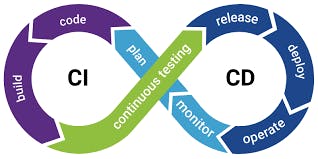Introduction
In today's fast-paced and competitive world of software development, efficiency and speed are paramount. Developers and businesses strive to deliver high-quality software products while reducing the time it takes to go from code changes to production. This is where Continuous Integration and Continuous Deployment (CI/CD) come into play. 🎯
What is CI/CD? 🌐
CI/CD, short for Continuous Integration and Continuous Deployment, is a set of practices that enable developers to automate the process of integrating code changes into a shared repository (Continuous Integration) and deploying the changes to production or other environments (Continuous Deployment) in a rapid and consistent manner.

How CI/CD Work?💡
- Continuous Integration (CI) 🔄
Continuous Integration is the first step in the CI/CD pipeline. It involves automatically integrating code changes from multiple developers into a shared version control repository. Each time a developer pushes new code, a series of automated tests and checks are triggered. These tests help detect any integration issues or bugs early in the development process.
Example: Consider a team of developers working on a web application. With CI in place, every time a developer makes changes to the codebase and pushes it to the central repository, the CI system automatically runs a suite of tests to ensure that the new code integrates smoothly with the existing codebase.
- Continuous Deployment (CD) 🚀
Continuous Deployment, on the other hand, is the next step in the CI/CD pipeline. It automates the process of deploying the successfully tested code changes to production or other environments. This ensures that the latest features and bug fixes reach end-users quickly and efficiently.
Example: After the CI process successfully completes its tests, the CD system automatically deploys the changes to a staging environment. Here, the changes undergo further testing by QA teams and product owners. If all tests pass, the CD system proceeds to deploy the code to the live production environment, making the new changes available to users.
🔑 Key Benefits of CI/CD
🏎️ Faster Time-to-Market: CI/CD reduces manual intervention and streamlines the development process, allowing companies to release software updates and new features at a much faster pace.
🚀 Improved Code Quality: Automated testing and continuous integration help catch bugs and issues early in the development cycle, leading to higher code quality and stability.
🔄 Agile Development: CI/CD facilitates an agile development approach by enabling developers to make smaller, more frequent code changes that are easier to manage and deploy.
🧪 Rapid Feedback: Developers receive immediate feedback from automated tests, allowing them to address issues promptly, enhancing collaboration, and promoting a culture of continuous improvement.
🛡️ Reduced Risk: Automated testing and deployments minimize the risk of introducing errors into the production environment, making it easier to roll back changes if needed.
🌐 CI/CD Tools and Services
Numerous CI/CD tools and services are available, catering to different development environments and requirements. Some popular ones include:
Jenkins 🕓: An open-source automation server that provides hundreds of plugins for building, deploying, and automating projects.
GitLab CI/CD 🦊: Integrated into GitLab, it offers a complete DevOps platform with built-in CI/CD capabilities.
Travis CI 🚦: A cloud-based CI service that automates building and testing code hosted on GitHub repositories.
CircleCI 🔄: A CI/CD platform that supports various programming languages and deployment targets.
Conclusion 🚀
In conclusion, CI/CD has revolutionized the software development industry by enabling faster, more efficient, and reliable delivery of software products. Embracing CI/CD practices empowers development teams to stay competitive in the ever-evolving digital landscape while ensuring top-notch software quality and user experience.
So, if you're looking to take your software development process to the next level, consider adopting CI/CD and experience the transformative power it brings to your projects! 🌟
